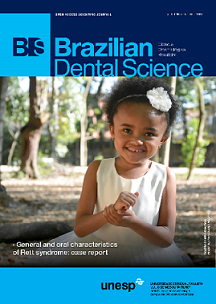Commercial antimicrobials mouthrinses on caries and periodontitis-related biofilm control: a review of literature
DOI:
https://doi.org/10.14295/bds.2017.v20i3.1402Abstract
This review aims to discuss the antimicrobial potential of different mouthrinses in respect to the control of dental caries and periodontal disease. The survey was conducted using PubMed and the following keywords: "antimicrobial agent " or "antiplaque agent," "dental biofilm" and "dental caries" or "periodontal disease" or "gingivitis". Only studies published in English, from 2011 to 2015, in journals with impact factor greater than 0.8, were selected. We found a total of 22 papers, 13 related to dental caries and 9 related to periodontal disease. Among the 13 studies involving cariogenic bacteria and/or biofilm, 6 were conducted in vitro, 3 in situ and 4 in vivo. Among 9 studies involving periodontal disease, 2 were in vitro and 7 in vivo. The main active agents tested were: CHX-Chlorhexidine, CPC-cetylpyridinium chloride and EO-Essential oils (alcohol/or alcohol-free). CHX was compared to EO in 6 studies, showing superiority in 3 studies, similarity in 1 study and inferiority in 2 studies. CPC has shown lower effect in plaque reduction compared to CHX and EO. There is still controversy about the effect of alcohol, but some studies have shown superiority for EO and CHX with alcohol on cariogenic and periodontopathogenic biofilms, respectively, when compared to alcohol-free version; for CPC, no difference was found. More clinical studies are needed for better understanding the mechanism of action and the differences in performance among the antiplaque agents.
Keywords
Antimicrobial agents; Dental biofilm; Dental caries; Oral diseases; Periodontitis.
Downloads
Downloads
Additional Files
Published
How to Cite
Issue
Section
License
Brazilian Dental Science uses the Creative Commons (CC-BY 4.0) license, thus preserving the integrity of articles in an open access environment. The journal allows the author to retain publishing rights without restrictions.
=================




























